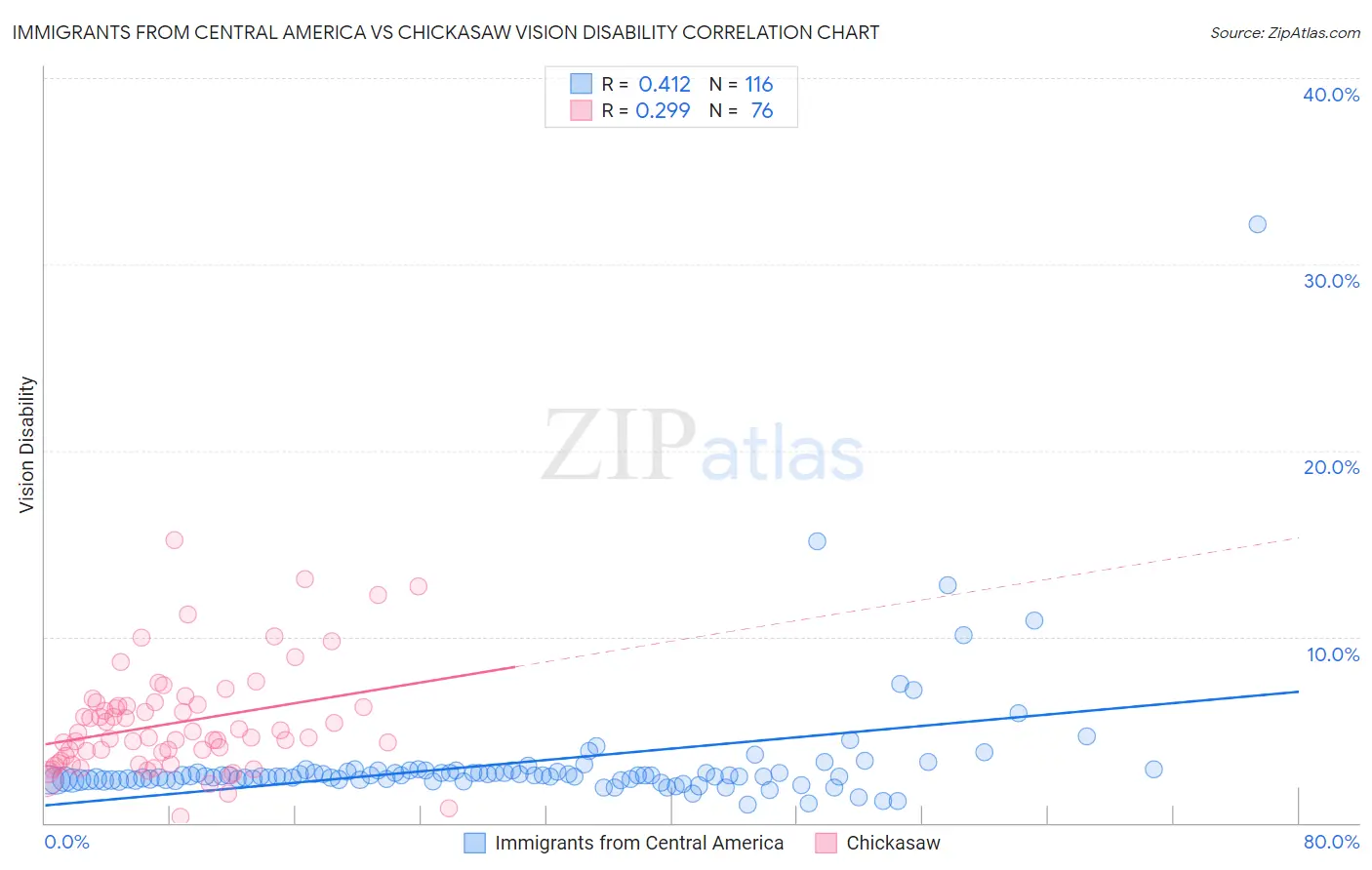Immigrants from Central America vs Chickasaw Vision Disability
COMPARE
Immigrants from Central America
Chickasaw
Vision Disability
Vision Disability Comparison
Immigrants from Central America
Chickasaw
2.5%
VISION DISABILITY
0.0/ 100
METRIC RATING
285th/ 347
METRIC RANK
3.2%
VISION DISABILITY
0.0/ 100
METRIC RATING
338th/ 347
METRIC RANK
Immigrants from Central America vs Chickasaw Vision Disability Correlation Chart
The statistical analysis conducted on geographies consisting of 535,338,761 people shows a moderate positive correlation between the proportion of Immigrants from Central America and percentage of population with vision disability in the United States with a correlation coefficient (R) of 0.412 and weighted average of 2.5%. Similarly, the statistical analysis conducted on geographies consisting of 147,658,152 people shows a weak positive correlation between the proportion of Chickasaw and percentage of population with vision disability in the United States with a correlation coefficient (R) of 0.299 and weighted average of 3.2%, a difference of 28.9%.

Vision Disability Correlation Summary
| Measurement | Immigrants from Central America | Chickasaw |
| Minimum | 1.00% | 0.33% |
| Maximum | 32.1% | 15.2% |
| Range | 31.1% | 14.8% |
| Mean | 3.2% | 5.4% |
| Median | 2.5% | 4.6% |
| Interquartile 25% (IQ1) | 2.3% | 3.5% |
| Interquartile 75% (IQ3) | 2.7% | 6.3% |
| Interquartile Range (IQR) | 0.43% | 2.9% |
| Standard Deviation (Sample) | 3.4% | 2.8% |
| Standard Deviation (Population) | 3.4% | 2.8% |
Similar Demographics by Vision Disability
Demographics Similar to Immigrants from Central America by Vision Disability
In terms of vision disability, the demographic groups most similar to Immigrants from Central America are Yakama (2.5%, a difference of 0.010%), Sioux (2.5%, a difference of 0.010%), Honduran (2.5%, a difference of 0.15%), French American Indian (2.5%, a difference of 0.18%), and Puget Sound Salish (2.5%, a difference of 0.30%).
| Demographics | Rating | Rank | Vision Disability |
| Spanish | 0.0 /100 | #278 | Tragic 2.4% |
| Nepalese | 0.0 /100 | #279 | Tragic 2.4% |
| Cape Verdeans | 0.0 /100 | #280 | Tragic 2.4% |
| U.S. Virgin Islanders | 0.0 /100 | #281 | Tragic 2.5% |
| Immigrants | Caribbean | 0.0 /100 | #282 | Tragic 2.5% |
| Puget Sound Salish | 0.0 /100 | #283 | Tragic 2.5% |
| Yakama | 0.0 /100 | #284 | Tragic 2.5% |
| Immigrants | Central America | 0.0 /100 | #285 | Tragic 2.5% |
| Sioux | 0.0 /100 | #286 | Tragic 2.5% |
| Hondurans | 0.0 /100 | #287 | Tragic 2.5% |
| French American Indians | 0.0 /100 | #288 | Tragic 2.5% |
| Immigrants | Nonimmigrants | 0.0 /100 | #289 | Tragic 2.5% |
| Immigrants | Cuba | 0.0 /100 | #290 | Tragic 2.5% |
| Immigrants | Honduras | 0.0 /100 | #291 | Tragic 2.5% |
| Crow | 0.0 /100 | #292 | Tragic 2.5% |
Demographics Similar to Chickasaw by Vision Disability
In terms of vision disability, the demographic groups most similar to Chickasaw are Tsimshian (3.2%, a difference of 0.69%), Creek (3.2%, a difference of 0.82%), Dutch West Indian (3.2%, a difference of 0.91%), Alaskan Athabascan (3.1%, a difference of 0.93%), and Navajo (3.1%, a difference of 1.1%).
| Demographics | Rating | Rank | Vision Disability |
| Central American Indians | 0.0 /100 | #331 | Tragic 3.0% |
| Seminole | 0.0 /100 | #332 | Tragic 3.1% |
| Cajuns | 0.0 /100 | #333 | Tragic 3.1% |
| Cheyenne | 0.0 /100 | #334 | Tragic 3.1% |
| Navajo | 0.0 /100 | #335 | Tragic 3.1% |
| Alaskan Athabascans | 0.0 /100 | #336 | Tragic 3.1% |
| Dutch West Indians | 0.0 /100 | #337 | Tragic 3.2% |
| Chickasaw | 0.0 /100 | #338 | Tragic 3.2% |
| Tsimshian | 0.0 /100 | #339 | Tragic 3.2% |
| Creek | 0.0 /100 | #340 | Tragic 3.2% |
| Kiowa | 0.0 /100 | #341 | Tragic 3.3% |
| Choctaw | 0.0 /100 | #342 | Tragic 3.3% |
| Pima | 0.0 /100 | #343 | Tragic 3.3% |
| Pueblo | 0.0 /100 | #344 | Tragic 3.3% |
| Lumbee | 0.0 /100 | #345 | Tragic 3.4% |